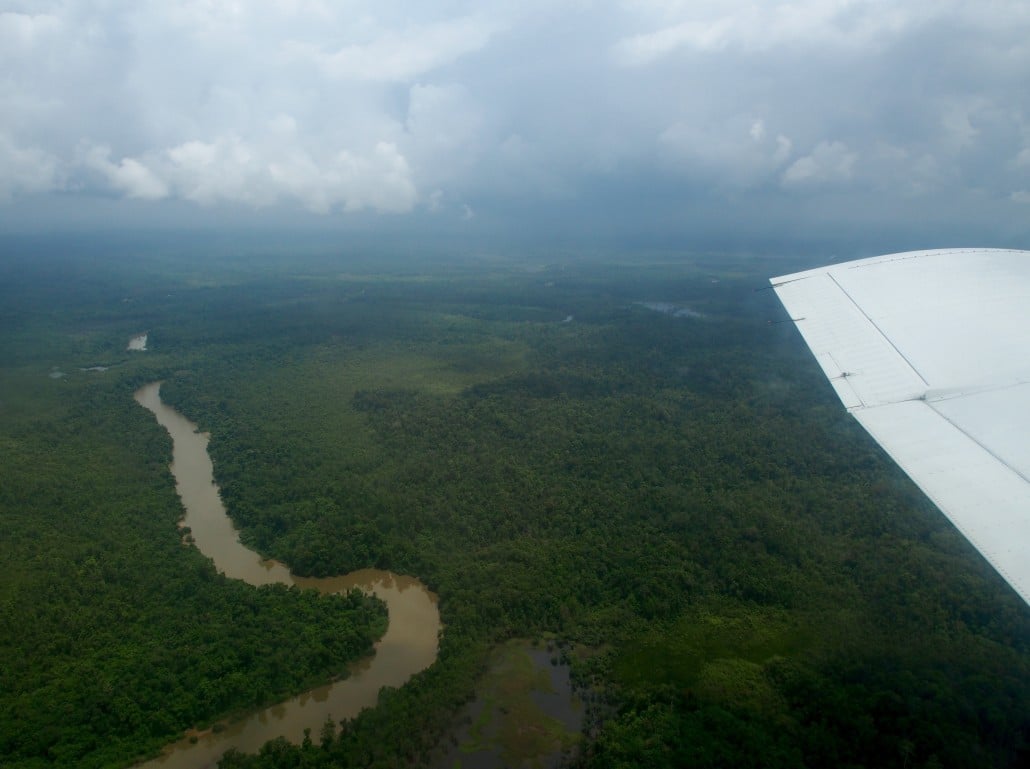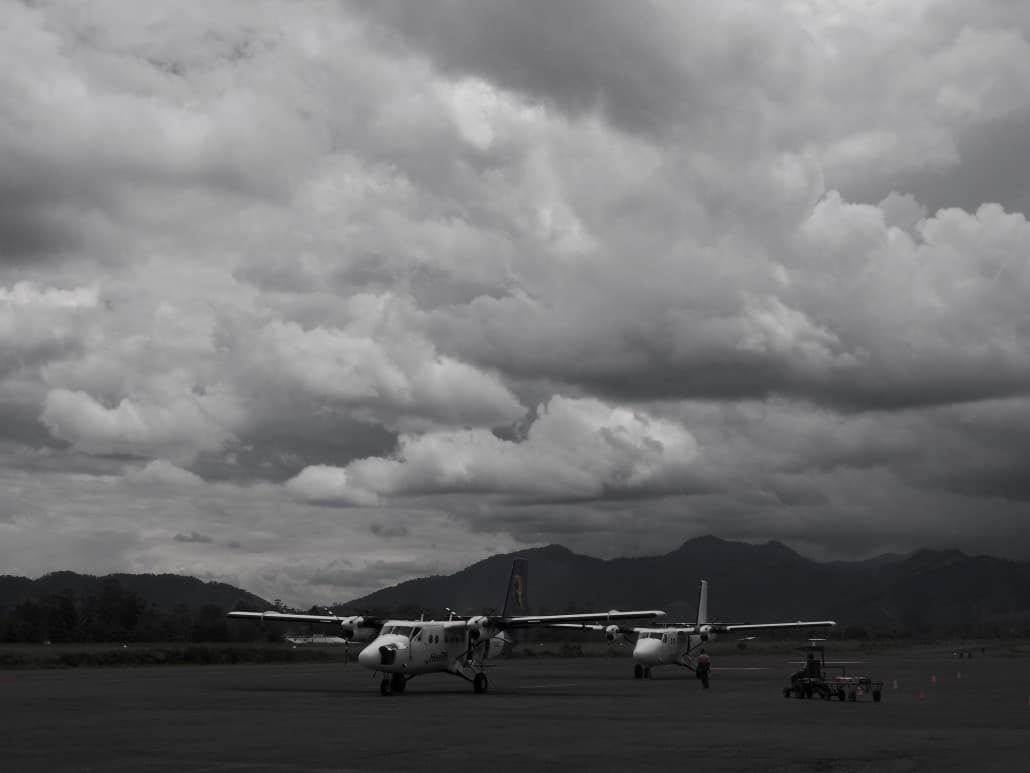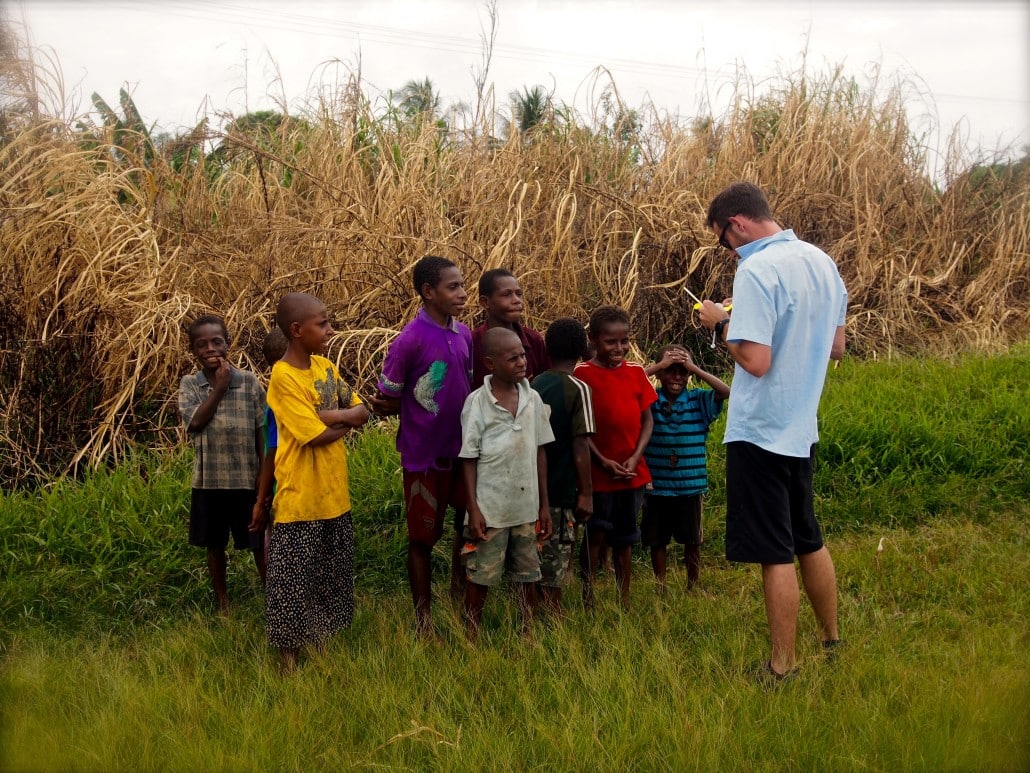
1. Far and further
The photo above is not of Port Moresby, the Papuan capital of some 400,000 people. Clearly. It is of the wild of Papua New Guinea’s Western Highlands from a few thousand feet up, where I sat at the moment my shutter clicked inside a wobbling nine-seat aircraft, strapped in by over-the-shoulder seatbelt. At that moment, my group was several steps beyond the relative modernities of Port Moresby. To get to this point, we had:
- Flown an hour north from Port Moresby to Mount Hagen, the third-largest city in PNG (~45,000 people)
- Spent a night at Mount Hagen’s Rondon Ridge (owned, like the plane, by Trans Niugini Tours)
- Boarded this flight from Mount Hagen bound for Lake Murray
We had found far-flung adventure at these earlier stops, but we were pushing still further into it—into the uncorrupted, green-and-curling-muddy-river Papua New Guinea of the imagination. Below the plane’s wing, the far reaches of that imagination, and of our planet’s face, were closer than I’d ever seen them.
As an entry point, and as a layover between deeper PNG excursions, Port Moresby yielded plenty of surprise, but as an outlet for real Papuan daring, it was just the beginning. Port Moresby is dusty and nondescript, but it is recognizably an urban environment. Cars rumble around busy roundabouts, kicking up loose rocks; there are homes, offices, billboards advertising mobile carriers. There is a mall that each December hosts the “largest indoor Christmas tree in the South Pacific,” and inside the mall is a nightclub, where for a “jug” (pitcher) of SP beer it is 50 kina (currently 0.33 to a US dollar). Especially near the airport, where expat compounds line the hillside, open real estate is increasingly elusive.
Outside the city, the distance between known and new accelerates at an exponential rate. One day, you’re marveling at the idiosyncrasies of Port Moresby’s Airways Hotel, and the next you’re floating in the mild oblivion of Lake Murray, your mind a clean slate. You can always go further, weirder, wilder, more dangerous in Papua New Guinea and in my experience, that’s an amazing thing.

2. Mudmen in Pogla
Safely in the weirder and wilder category is the transcendent story of the mudmen, here reenacted for us in Pogla village outside Mount Hagen. What on Earth was being reenacted?
Generations ago, somewhere in folkloric Papua New Guinea, there was a conflict between clans, one smaller than the other by many men. As the story goes, the outmatched smaller clan—the underdog—was pushed off its land by its larger foe and banished to the hills above. The larger clan was then content; the smaller clan was not. And so when the fog rolled in one night, the men of the smaller clan painted their bodies in grey, runny mud. They fastened claw-like bamboo segments to their fingers, and they hid their faces inside heavy, haunting clay masks. Exploiting vulnerabilities in the spirit-fearing dogma of the day (which lingers in 2016), the “mudmen” descended upon their old home disguised as their own ghostly ancestors seeking to reclaim the sullied land. The larger clan was spooked, convinced and defeated, and in defeat it fled. And PNG’s most famous underdog story was born.
The story of the mudmen does not belong to Pogla, nor today to any particular Papuan village, clan or tribe. The most accepted origin story places its inspiration in the Eastern Highlands, but the true birthplace doesn’t really matter. In the performance I witnessed, what mattered most was the genuine unease the mudmen induced in a new audience, and the shiver-inducing clacks of sharpened bamboo fingers cutting through the humid air. Smoke poured from a fire, cloaking the deliberate movements of mud-smeared bodies creeping toward us. It all happened so slowly—clack!…………clack!—until suddenly there were long, slow-twisting bamboo fingers inches my face.
The ghosts of PNG past, calculated as they were, slipped silently out of the palmy brush and into our Malarone dreams that day (as Will put it). In a larger sense, they showed us that everyone on Earth, in some from or another, likes an underdog story.

3. Open skies at Mount Hagen airport
In Papua New Guinea, you spend a lot of time walking around on runways with mountain backdrops (like in Mount Hagen, above). You see airports stripped down to their functional minimums, as just waiting areas and runways; during a stopover in Tari, our pilot walked off airport premises for cigarettes while we killed time in a sort of gazebo beside the tarmac.
Flying is simply a different beast in Papua New Guinea. Outside of Port Moresby and a few small airports, the tourism network is essentially a series of discrete points, like pins on a corkboard map. Roads and land routes occasionally exist between them, but infrastructure is overwhelmingly lacking, particularly in the west, north and far east (islands like Bougainville and New Britain). Small-plane and charter flights (arranged by able agents like Trans Niugini Tours) drop you out of the sky into whatever new world is on your itinerary that day, and later, they return to pluck you for your return to civilization. They are the logic in deeper PNG navigation; without them, it’s really hard to make sense of the landscape. It’s also a huge country made all the more indomitable by the complexities of its tribal life—and so in Papua New Guinea, you fly.
You also place your trust in your pilots. The best of them, for now mostly westerners that have for whatever reason (money, opportunity) taken work in Papua New Guinea, are big personalities full of big stories. You share moments with them in and out of the sky—moments that drag the world of PNG alternatingly further from and closer to western comprehension. There is an intimacy to flying within this map that you feel like the pounding noise of an engine in flight. I’m convinced I learned about the mechanics of flying through observation alone sitting two feet from Matt at the rudder. Also: I learned that somewhere rural, and it doesn’t matter where, a clan planted a tree on an airstrip to disrupt air access, and it worked—until one day a Kiwi pilot took a machete to it and opened it back up.

4. Pilot Matt and local kids on the airstrip
From Mount Hagen, the flight to Lake Murray is a little over an hour, but I suppose it depends on your pilot. Ours—Matt, in the sky blue shirt—looped in a two-minute detour for better views of Lake Murray Lodge. Nice. Matt then swung his nine-seater down toward the green Papuan Earth, which from about 500-feet up appeared unfit to receive a plane. But the grassy strip seen in part above, overgrowth and all, took us in with a bump.
We unfurled ourselves, and then our bags from a compartment beneath the cabin, with eyes on us. The sound of our 750-horsepower turbine engine had drawn an audience of curious Lake Murray locals, among them children of varying heights. They stood solo and in groups, just off the airstrip and just visible off in the distance—eyes, even from afar, on us. Others peaked through the brush bristling in the light wind. They wanted to see us, and we wanted to see everything. The moment held a lot to take in.
But pilot Matt, transplanted New Zealander—Matt had done this before. From the belly of the plane, he produced a box of corrugated cardboard about the size of a laundry basket. The flaps on top were unfastened, and he scooped out a couple of those T-shaped plastic helicopter toys you spin with your hands (like these) and stepped confidently toward the closest congregation of kids. With his own hands, he showed them how—and then the helicopters passed between hands, we saw them twirling in the air, and we were off to Lake Murray Lodge by foot.
He’d bought a thousand of these toys online, Matt later told us, for $1000, and the moment we witnessed was a reoccurring one. It won’t last forever, but for now, in Papua New Guinea, first impressions mean a lot.

5. Cannibal waste?
Actually, yes. On one of the evenings I slept at Nuli Sapi, before a phenomenal dinner of chili crab on the water, we walked in the footsteps of cannibals. As the couple running Nuli Sapi—Australian Kayleigh and Joe from Louisiana—prepared our meal, a local associate walked us off the wooden Nuli Sapi boardwalk and into the rainforest of Logeia Island. We curled around large roots on some style of trail for ten, 15, 20 minutes as darkness crept closer, our trust fully tethered to this man promising us a cave of skulls.
Cannibalism left PNG for good in the 70s, this man assured us, and the act itself existed historically as a symbol in clan violence. There was no nutritional agenda, and even as a tool of war it was rarely fastened. And then the walking stopped, and we were looking at some 70 human skulls shelved inside a rocky crevice. With prompting, we took them in our hands and grappled, for a few moments, with the death of cannibalism as the exotic measuring stick. The human skull I hold in the photo above is a real part of the world’s history. As we trekked back toward dinner on Milne Bay, the feelings from our cannibalism encounter fell away into the larger, disorienting reality of this PNG trip. Beneath streaks of clouds and a bright moon, we arrived home—at four over-water bungalows made of bush materials on the other side of the world.
In Part 4: 5 more photos from Papua New Guinea. Part 2 is available here. Part 1 is available here.
For more on travel to Papua New Guinea, check out papuanewguinea.travel and pngtours.com.
